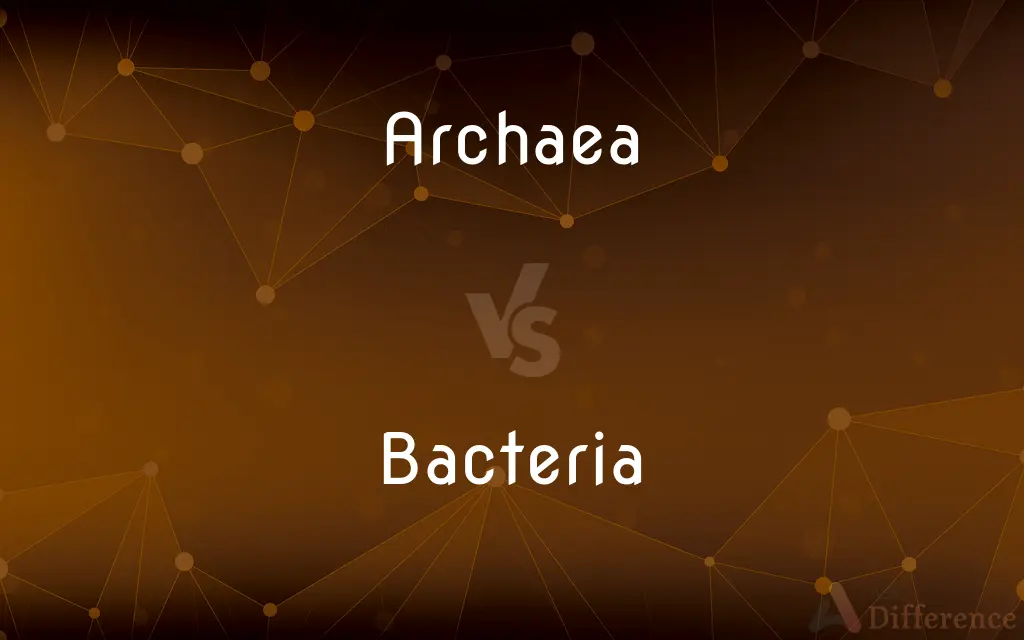Archaea vs. Bacteria — What's the Difference?
By Tayyaba Rehman — Updated on September 21, 2023
Archaea are single-celled organisms without nuclei, distinct from bacteria in genetics and membrane composition; Bacteria are single-celled organisms with varying shapes and metabolic types.

Difference Between Archaea and Bacteria
Table of Contents
ADVERTISEMENT
Key Differences
Archaea and bacteria both belong to the prokaryotic domain, meaning they are single-celled organisms without a nucleus. However, despite their similarities, they exhibit significant genetic differences. While bacteria encompass a vast variety of familiar microorganisms, archaea are less well-known and often reside in extreme environments.
In terms of cellular structure, the cell membranes of archaea and bacteria are fundamentally different. Archaeal membranes consist of branched hydrocarbon chains attached to glycerol, whereas bacterial membranes have straight-chain fatty acids attached to glycerol.
It's essential to understand that archaea are often adapted to extreme environments like hydrothermal vents and salt flats. In contrast, bacteria have a broader range of habitats, from soil and water to human skin and the digestive tract.
The RNA sequences, particularly in the ribosomal RNA, between archaea and bacteria differ significantly. This distinction has helped scientists understand the evolutionary relationship between these two domains, positioning archaea closer to eukaryotes than bacteria.
Antibiotics affect bacteria but often do not impact archaea. This resistance exhibited by archaea stems from their unique cell wall composition and other cellular differences from bacteria.
ADVERTISEMENT
Comparison Chart
Genetic Makeup
Distinctly different from bacteria
Varied but different from archaea
Cell Membrane Composition
Branched hydrocarbon chains attached to glycerol
Straight-chain fatty acids attached to glycerol
Typical Habitats
Often found in extreme environments
Wide range including soil, water, and human body
Ribosomal RNA (rRNA)
Closer in sequence to eukaryotes
Distinct from both archaea and eukaryotes
Antibiotic Sensitivity
Often resistant to antibiotics
Typically affected by antibiotics
Compare with Definitions
Archaea
Single-celled organisms lacking nuclei and resembling early life forms
Archaea thrive in some of Earth's harshest environments.
Bacteria
Prokaryotes that lack a true nucleus
The DNA of bacteria floats freely within the cell.
Archaea
Categorized in a separate domain from bacteria and eukaryotes
Archaea stand out due to their unique characteristics.
Bacteria
Microscopic single-celled organisms found nearly everywhere
Bacteria play a crucial role in many ecosystems.
Archaea
Prokaryotes distinct from bacteria in genetic makeup
The study of archaea provides insights into early life on Earth.
Bacteria
Typically have varied shapes such as rods, spirals, and spheres
Rod-shaped bacteria are termed bacilli.
Archaea
Have a unique cellular membrane composition
The archaeal cell membrane helps them survive in harsh conditions.
Bacteria
Bacteria ( (listen); common noun bacteria, singular bacterium) are a type of biological cell. They constitute a large domain of prokaryotic microorganisms.
Archaea
Known for surviving in extreme environments
Some archaea species live in boiling water vents.
Bacteria
Plural of bacterium.
Archaea
Archaea ( (listen) ar-KEE-ə; singular archaeon ) constitute a domain of single-celled organisms. These microorganisms lack cell nuclei and are therefore prokaryotes.
Bacteria
(US) A type, species, or strain of bacterium.
Archaea
Any of various prokaryotic microorganisms of the domain Archaea, being genetically distinct from bacteria and often living in habitats with extreme environmental conditions such as high temperature or salinity. Also called archaebacterium.
Bacteria
Alternative form of bacterium.
Archaea
Plural of archaeon
Bacteria
Lowlife, slob (could be treated as plural or singular).
Bacteria
An oval bacterium, as distinguished from a spherical coccus or rod-shaped bacillus.
Bacteria
See Bacterium.
Bacteria
(microbiology) single-celled or noncellular spherical or spiral or rod-shaped organisms lacking chlorophyll that reproduce by fission; important as pathogens and for biochemical properties; taxonomy is difficult; often considered plants
Bacteria
Known for their diverse metabolic types and capabilities
Some bacteria can photosynthesize like plants.
Bacteria
Can be harmful (pathogenic) or beneficial
Beneficial bacteria help in digestion.
Common Curiosities
Are all bacteria harmful to humans?
No, while some bacteria can cause diseases, many are beneficial and essential for our health.
Are archaea a type of bacteria?
No, archaea and bacteria are two separate domains of prokaryotic organisms.
How do archaeal cell membranes differ from bacterial ones?
Archaeal membranes consist of branched hydrocarbon chains, while bacterial membranes have straight-chain fatty acids.
Where can archaea typically be found?
Archaea often inhabit extreme environments like hydrothermal vents, acidic lakes, and salt flats.
How do scientists distinguish between archaea and bacteria?
Differences in genetic makeup, cellular structure, and membrane composition help differentiate them.
Why are some bacteria called "good bacteria"?
Some bacteria are beneficial to humans, aiding digestion and outcompeting harmful bacteria.
Can archaea be seen with the naked eye?
No, like bacteria, archaea are microscopic.
What's the importance of studying archaea?
Understanding archaea offers insights into early life on Earth and extremophiles.
Do both archaea and bacteria lack a nucleus?
Yes, both are prokaryotes and do not have a true nucleus.
Which group is older, archaea or bacteria?
Both archaea and bacteria are ancient, but it's unclear which group emerged first.
Can bacteria live in extreme environments like archaea?
Some bacteria can thrive in extreme conditions, but archaea are especially known for this trait.
Do antibiotics work on archaea?
Archaea are generally resistant to antibiotics that affect bacteria.
Do archaea cause diseases in humans?
Unlike bacteria, archaea are not known to cause diseases in humans.
Share Your Discovery

Previous Comparison
Splenda vs. Stevia
Next Comparison
Dearborn vs. WagonAuthor Spotlight
Written by
Tayyaba RehmanTayyaba Rehman is a distinguished writer, currently serving as a primary contributor to askdifference.com. As a researcher in semantics and etymology, Tayyaba's passion for the complexity of languages and their distinctions has found a perfect home on the platform. Tayyaba delves into the intricacies of language, distinguishing between commonly confused words and phrases, thereby providing clarity for readers worldwide.












































